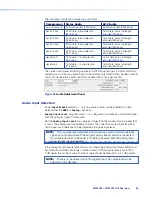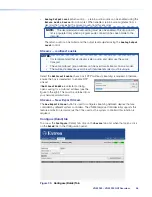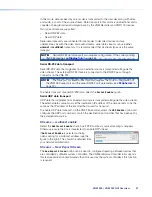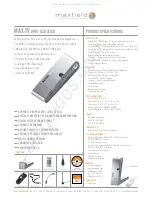
Pass-through mode
In this mode, data received by a device (input) is transmitted over the network using
TCP/IP and then converted back to serial data by a second device (output). Data flow is fully
bidirectional and is independent of whether the VN-Matrix device is an encoder or decoder.
Pass-through data cannot be recorded.
One device in the pass-through group is designated the server. One or more devices are
connected as clients (in pass-through mode).
TCP
RS-232
TCP
TCP
TCP
RS-232
RS-232
RS-232
Network
VN-Matrix (Clients)
VNE 250
VN-MATRIX RGB / HDMI OVER IP
CONTROL
MENU
NEXT
ADJUST
STREAM
STATUS
CONFIG
ALARM
VND 250
VN-MATRIX RGB / HDMI OVER IP
CONTROL
MENU
NEXT
ADJUST
STREAM
STATUS
CONFIG
ALARM
VND 250
VN-MATRIX RGB / HDMI OVER IP
CONTROL
MENU
NEXT
ADJUST
STREAM
STATUS
CONFIG
ALARM
VND 250
VN-MATRIX RGB / HDMI OVER IP
CONTROL
MENU
NEXT
ADJUST
STREAM
STATUS
CONFIG
ALARM
RS-232 serial data input to the server
is sent to all clients simultaneously.
Data input to each client is sent to the
server output. Simultaneous data input
is processed on a "first in, first out" basis.
VN-Matrix (Server)
Figure 27.
Example of Pass-through Mode
Any number of serial pass-through groups can exist on the same network.
Serial Port Control
Select a serial port
mode
(see
,
1
, on the previous page):
•
none
- the serial port is not used
•
server
- the serial port is used to send serial RS-232 data to clients
•
client
- the serial port can connect to the server serial ports on other devices
A pass-through link can be established by setting the serial port of one device in server
mode and the serial port of a second device in client mode. The destination of the second
(client) device is set to the pass-through port on the first (server) device.
NOTE:
The destination can only be modified when the serial port is operating in
client mode. The pulldown list allows a pass-through connection to be requested to
each VN-Matrix device in the network, regardless of whether the device is currently
configured as a server.
A server can accept multiple client connections. Under these conditions the data input
by the server serial port is duplicated to all connected clients. The data received from the
clients is multiplexed (in order of arrival) and output through the server serial port.
The basic operation parameters of the serial port can be controlled on a device by device
basis. There is no requirement for a server and connected client to share a common baud
rate. However if serial data is continuously input at a high rate, some handshaking is
required otherwise data is discarded when the internal buffer overflows.
Serial RS-232 Data Channel
In this mode, serial RS-232 data received on the pass-through port is transported over the
network alongside the video stream. Data flow is unidirectional from the encoder to the
decoder and can be recorded synchronously with the other streams that are configured on
the encoder.
NOTE:
Serial mode for both the encoder and decoder must be set to server.
It is recommended that all serial port settings are the same for both the encoder and
decoder. Mismatches result in data being discarded if it arrives at a decoder faster than it
can be transmitted.
VNM 250 • VNM 250 GUI Overview
43
Summary of Contents for VN-Matrix 250 Series
Page 6: ......
















































